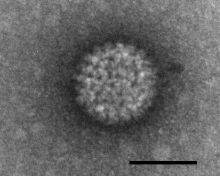Veterinary virology

Veterinary virology is the study of viruses in non-human animals. It is an important branch of veterinary medicine.
Rhabdoviruses

Foot-and-mouth disease virus
Pestiviruses
Pestiviruses have a single stranded, positive-sense RNA genomes. They cause Classical swine fever (CSF) and Bovine viral diarrhea(BVD). Mucosal disease is a distinct, chronic persistent infection, whereas BVD is an acute infection.[3]
Arteriviruses
Coronaviruses are enveloped viruses with a positive-sense RNA genome and with a nucleocapsid of helical symmetry. They infect the upper respiratory and gastrointestinal tract of mammals and birds. They are the cause of a wide range of diseases in cats, dog, pigs, rodents, cattle and humans. Transmission is by the faecal-oral route.[5]
Toroviruses
Influenza
Influenza is caused by RNA viruses of the family Orthomyxoviridae and affects birds and mammals.
Avian influenza
Wild aquatic birds are the natural hosts for a large variety of influenza A viruses. Occasionally viruses are transmitted from this reservoir to other species and may then cause devastating outbreaks in domestic poultry or give rise to human influenza pandemics.[7]
Swine influenza
Bluetongue virus
Circoviruses
Circoviruses are small single-stranded DNA viruses. There are two genera: gyrovirus, with one species called chicken anemia virus; and circovirus, which includes porcine circovirus types 1 and 2, psittacine beak and feather disease virus, pigeon circovirus, canary circovirus, goose circovirus.[10]
Herpesviruses
African swine fever virus
African swine fever virus (ASFV) is a large double-stranded DNA virus which replicates in the cytoplasm of infected cells and is the only member of the Asfarviridae family. The virus causes a lethal haemorraghic disease in domestic pigs. Some strains can cause death of animals within as little as a week after infection. In other species, the virus causes no obvious disease. ASFV is endemic to sub-Saharan Africa and exists in the wild through a cycle of infection between ticks and wild pigs, bushpigs and warthogs.[12]
Retroviruses
Retroviruses are established pathogens of veterinary importance. They are generally a cause of cancer or immune deficiency.[13]
Flaviviruses
Paramyxoviruses
Parvovirus
Parvoviruses can cause
See also
- Bat virome
- History of virology
- Social history of viruses
- Virus evolution
References
- ISBN 978-0-12-375144-7.
- ISBN 978-0-12-375144-7.
- ISBN 0-12-511340-4.
- ISBN 978-0-12-375144-7.
- ISBN 978-0-12-375158-4.
- PMID 11444035.
- ISBN 978-0-12-375158-4.
- ISBN 978-0-12-375158-4.
- ISBN 978-0-12-375144-7.
- ISBN 978-0-12-375144-7.
- ^ "ICTV Master Species List 2018b.v2". International Committee on Taxonomy of Viruses (ICTV). Archived from the original on March 30, 2019. Retrieved 19 June 2019.
- ISBN 978-0-12-375158-4.
- ISBN 978-0-12-375158-4.
- ISBN 978-0-12-375144-7.
- ISBN 978-0-12-375158-4.
- ISBN 978-1-4051-3645-7.
- ISBN 0-12-253056-X.
